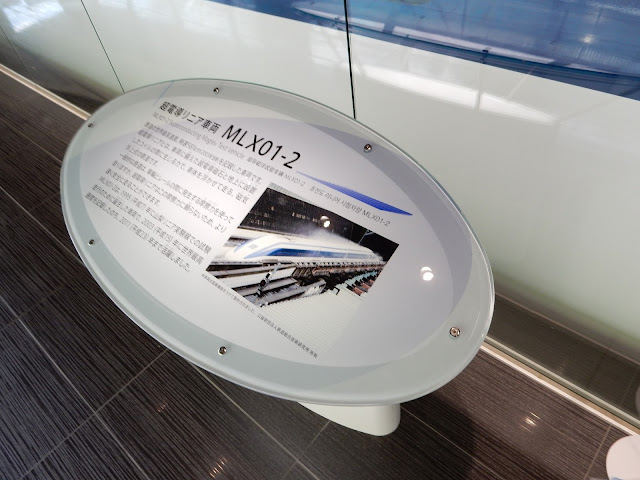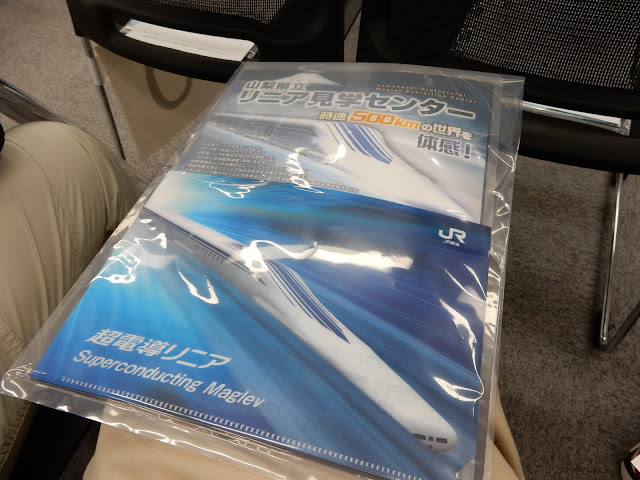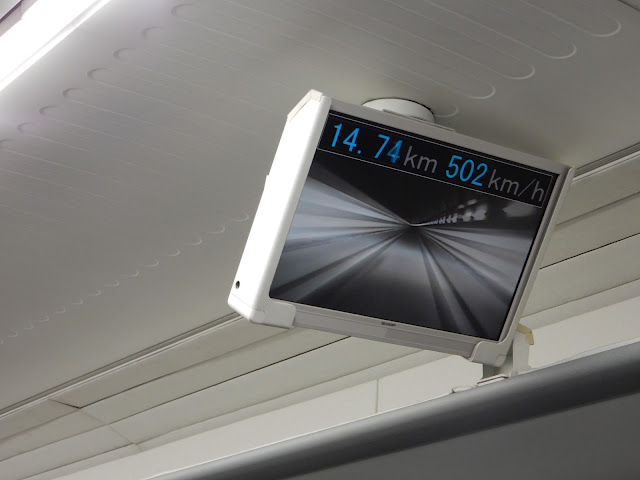Today I want to look at my first ever ride of the brand new (not in production use) Linear Maglev Shinkansen!! Thats right, the worlds fastest train at 603 km/h, which is due to go into service from Tokyo to Nagoya in 2027 and ultimately to Osaka later on.
This track will form part of the Tokyo to Osaka maglev line being constructed right now.
So how did I manage to get a ticket to ride this train some 11 years before it is due to go into service?
Well, you can enter a lottery from JR to score a ticket to ride on the Maglev train during a number of test runs of the train on specific days.
Unfortunately the website and process is all in Japanese, and it is for Japanese residents only. Fortunately as my wife is Japanese and her parents live in Japan, we could apply using their address! :-)
To be honest I didn't expect to get a ticket as it is extremely difficult to get tickets due to high demand to try out this latest and greatest Japanese train, but we did!
We received a postcard in the mail in Japan with the details to get to the Yamanashi test centre and our registration number and other details needed to check-in once there for a ride on the Maglev. I was really excited and couldn't wait!
Yamanashi is a long way from Tokyo, and the destination station Otsuki (nearest to the test centre) is on the Chuo main line. So first we hopped on the Yamanote line train from Shibuya to Shinjuku station.
For those unfamiliar, Shinjuku is the busiest train station in the world, with over 4 million passengers using it per day! It is always busy:
I took a look at the Chuo main line platforms and saw plenty of JR East train movements with the Chuo main line being a very busy line indeed:
Across from the Chuo line platform is the Sobu line (yellow coloured trains):
Here is the Chuo main line train (Orange colour) arriving at the platform:
There is Special Rapid, Rapid and local trains, with the lit stations on the board showing which stations the next train will stop at:
We were in Carriage 8 for this trip:
The internal carriages are nice and comfortable, without being too fancy. It is firmly in the commuter usage, although more expensive than the Chuo main line due to the express nature of the service, skipping many stations:
Here is the view from our seats as we prepared to leave Shinjuku:
Once on our way we were hungry as it was midday and we decided to grab a ekiben (Station lunch) to eat on the train from the mobile food/souvenir service that runs through the train - I also bought a Japan suica train pass holder with a picture of the Kaiji train on it:
The train has toilet and bathroom facilities too:
Eventually we arrived at Otsuki station:
Given we were about to experience the fastest train in the world, this poster at Otsuki station seemed very appropriate for our feelings at that moment!
Outside Otsuki Station:
This is the bus that takes us to the Yamanashi Linear Maglev test train centre where the Linear Maglev Shinkansen train runs:
After about 20 minutes we arrived at the Yamanashi Linear Maglev test train centre:
We had some free time before our train was due to run, so we first went to the newly built Yamanashi Maglev Exhibition centre next door:
Today was very hot indeed, so keeping out of the sun was certainly a priority!
Here is the ticket we bought for entering the exhibition centre:
For those with any interest in the amazing Linear Maglev technology Japan has developed - this is the place to go!
On display is this earlier test Linear Maglev train, MLX01-2:
You can go inside, and here is the inside of that older test train:
A lot of information and interactive displays (mostly in Japanese) explain how Maglev technology works, and shows the history of Maglev technology in Japan, which has been ongoing for 50 years!
The various iterations of Maglev test vehicles over the past 50 years is also shown:
You can see how they changed the track from a centre to outside profile as they determined the optimal use of the technology for greater speed and passenger comfort:
A full timeline is shown, with significant milestones in the development:
Here you can see the target date on 2027 for the line to be opened:
Here is a close look at the superconducting magnets on the side of the earlier Maglev test train:
The interactive displays to show how Maglev technology works were fascinating, although I wish I could read Japanese better!
They even had a mini maglev vehicle you could ride in the exhibition centre:
For me though, I only had eyes for riding the real actual Maglev train - speaking of which from the top floor of the Exhibition Centre we can see it as it briefly comes out of the tunnel at this location:
As you can see there is no driver window, as there is no driver. The train is controlled remotely. Japan has used this kind of technology for years in other Tokyo suburban lines like the Yurikamome line.
You can see the two passenger entry retractable airbridges well in this photo:
The Exhibition centre also has a Diorama showing local trains and the new Linear Maglev Shinkansen passing through planned new stations in the Yamanashi area.
This next information board was particularly interesting for me - it shows the time it takes for a plane (80 minutes) and the current fastest Nozomi Shinkansen (138 minutes) to go to Osaka from Tokyo. It shows that the new Linear Maglev Shinkansen will take just 67 minutes to do the same route! This amazing train will make all plane travel from Tokyo to Osaka redundant and airlines are already preparing for that reality.
Amazing - this new train is faster than a plane. Can't wait to ride it.
Speaking of which, it was now time to make our way to the test train centre to get our tickets. We had to bring our passports and the invitation postcard.
The security bag checks and printing our own tickets feels exactly like we are about to board a plane rather than a train - here is the ticket printing machine:
This is the entry foyer before going into the waiting room for the train - attendants scan your ticket to enter the waiting room, just like a plane:
Here is the waiting room, which you can see is ordered with passengers seated in order in the carriage they will be boarding:
We were given a welcome pack containing a Linear Maglev Shinkansen clear file and various souvenirs and information about the new train:
Here is the printed ticket for my ride on the Linear Maglev Shinkansen - scheduled for 2:25pm and of course this being Japan, it left exactly on time:
Typically over elaborate instructions abound - I reckon I can work out where the screen is, I am looking at it!
It tells us that today we will be travelling at 500km/h in the new Linear Maglev Shinkansen, which is 200km/h faster than the current Shinkansen travel at.
On the walls is lots of information showing the location of the new Maglev line from Tokyo (Shinagawa Station) to Nagoya, due to be completed by 2027.
Here is the Guiness World records certificate showing that this Maglev Shinkansen is the world fastest train, travelling in a test run at 603 km/h!
Here is some more boards in the waiting room showing the change of Linear Maglev test trains over the years:
Here they explain the test track is 42.8 kms long, and how the Maglev technology works:
A video was then shown which we were specifically told not to take photos or record video of - basically just an introduction showing the train itself and it's technology, which was quite interesting.
After this we were taken through to the train for boarding. Every step of this felt like being at an airport, about to board a plane:
The airbridges to enter the train itself continued this feeling:
Everyone was commenting how this felt exactly like boarding a plane - it really did!
My wife and I were in Car number 3 for this trip:
Tell me this doesn't feel like a plane!
Once inside, it looks and feels like the economy cabin on an aeroplane, with the seats and design similar to current Shinkansen models in service:
Looking around is the usual seat numbers and letters, same as the normal Shinkansen has:
What is different though is the monitors in the roof, which show the current location of the Maglev train, and the speed and video footage from the front of the train.
This is necessary as nearly all of the test run track is underground so there is very little to see out the windows except for a few places where the train briefly comes out into the open, like now, as we await departure:
Yamanashi prefecture looks quite spectacular in the summer, with the green mountains providing a lovely backdrop:
Here is some photos of the seats, which also recline:
Total travel time is around 30 minutes, and I was so excited:
The seats are usual Shinkansen fare, with tray table, drink holder and document holders. Given we couldn't bring drinks or food onto the train it seems a bit pointless though!
On the left side of the train there is a black ventilation running the length of the car providing air conditioning to the car. There are no other vents above the passenger, although there is a shelf for storing bags, etc.
Here is the view from inside the Maglev Shinkansen train with the shade drawn part way and with it open:
We then got underway and soon slowing down for our first run towards Nagoya at 500km/h:
With Maglev technology, there are no rails. The train has wheels on it and when the speed of the train reaches a critical speed (around 150 km/h), the wheels retract (exactly like on a plane) and the train is then suspended in air using the Magnetic levitation technology as the speed increases further and further.
Without physical rails the train can travel much faster than conventional electric trains and Shinkansen. The speed increase is fast but felt comfortable in the train. The noise inside the carriage was noticeable as we reached the top speed of 500km/h:
We burst out of the tunnel briefly allowing me to grab this shot as the scenery flew by faster than I have ever been on a train before:
It was an amazing experience:
Our top speed ended up being 502km/h:
We then slowed down (which takes a long time!) and when the speed drops below around 150km/h, the wheels come down and the train "lands" back on the track. Again, this feels exactly the same as a plane when it comes in to land - the sensation is identical.
We then stopped and went back the other way towards Tokyo, again at 500km/h, before slowing down before the end of the test track.
After this we then made our way back at a rather slow (in comparison) 325km/h back to the test centre to finish the ride.
With the ride completed, we disembarked - you can see from this shot how narrow the train is compared to other trains:
This is a view towards another car 2 from car 3 as we left:
These schedule screens show that the train runs 6 times on this particular day.
We were then taken to a viewing point where we could get some close up shots of the front of the Linear Maglev Shinkansen we just rode on:
We then left towards the souvenir shop as I didn't get a chance to look at it earlier before riding the train:
I went a little crazy in there and bought lots of souvenirs.
From the top floor of the Souvenir shop you can get another view of the Maglev Shinkansen track, here showing the maintenance vehicles:
Helpfully they have screens in the room to show the current position of the train and warning when it is about to (very briefly) pass you at 500km/h.
Luckily for me I could catch it when it was coming in to stop to get some more photos of this amazing train:
Coming here and riding this train of the future was a once in a lifetime experience and I am so grateful to have been able to have the opportunity to ride it, some 11 years before it will be used in regular passenger service.
We then caught the bus back to Otsuki station for the trip home:
Fujikyu Railways runs this train and several others on tourist train trips to Mt Fuji.
Another local train from Fujikyu railways arrived on their platforms while I was waiting at JR's platform for our return train:
The Otsuki Station board and local Chuo line train service stopped at the station:
Here is the almost empty Otsuki platform as we awaited our Kaiji train to go home:
Our carriage on the Kaiji service also included a separate sitting area, so I thought I would show some pictures of it as I hadn't noticed it earlier:
Here is the view of our carriage from the sitting area:
The Kaiji seats are certainly colourful:
When we arrived at Kichioji, we got off to transfer to the Inokashira line back to Shibuya (rather than going to Shinjuku). At the platform I saw a Super Azusa train arrive which also runs on the Chuo main line and is an older train with an interesting purple and white colour:
Here is the Inokashira line platforms at Kichioji - as you can see by this time it was getting quite late!
Here are two of the Keio Inokashira line trains at Kichioji station - which is the terminus station for this line, which starts at Shibuya station, and this is where we began our journey today!
The Inokashira trains have been replaced with new ones since my last visit to Japan, with everything looking very modern and clean inside.
Here is the view outside the doors of the platform, showing the protective barriers that stop people from running or falling in front of trains while they are moving - quite common in Japan. More and more of the barriers are being installed across the Tokyo train network.
Here is the Kochioji Station board:
We then headed back to Shibuya!
The trip on the Linear Maglev Shinkansen was fantastic. I loved every minute of it! More blog entries to come showing many other train trips I did while in Japan in July/August this year!



































































































































This comment has been removed by the author.
ReplyDeleteWhile visiting Japan in 2009, I was fascinated with my Shinkansen trip from Tokyo to Kyoto (I think it was 700 model).
ReplyDeleteI really like and appreciate you wrote this. You might call it luck to win the trip on lottery, but you have very well deserved it. It's obvious you enjoyed it and your review is great. Thank you for this.
Minor error noted: "semiconducting" should be "superconducting".
Cheers!
Thanks for your feedback - I am glad you enjoyed this blog entry! I had a great time travelling on this very special train. I will fix the typo - thanks for pointing it out :-)
DeleteEpsilon,
ReplyDeleteThank you for the comprehensive review of your experiences visiting the superconducting maglev system in Yamanashi Prefecture. Yours is the first report I’ve seen written from the perspective of a rail enthusiast and your passion for all things rail is evident throughout, in your personal observations, the many images and constant attention to details.
(As a side note, I appreciate the absence of negative comments about magnetic levitation as an alternative to steel-wheel systems. In my experience, it’s rare that a blog post or media article maintains such an objective stance.)
My last visit to the Yamanashi facility was five years ago. Through your blog post I can now see the many changes that have since been introduced to make the visitor experience more meaningful.
Best regards from America,
Larry Blow
http://www.maglevtransport.com
Thanks mate - I really appreciate your kind feedback. I am not sure why people would be negative about this very exciting train technology - I believe it is likely to be the future of high speed train travel. A train that is faster than a plane without the hassles of plane travel, check-in, etc - I say, yes please. Pity we'll probably never see this in Australia, a country that really could use this technology due to the long distances between cities. I cross my fingers for that...In the meantime I am very glad to have ridden the Linear Maglev Shinkansen this year!
DeleteNo worries mate - thanks for sharing it. I hope some of the members there enjoy the post! :-)
ReplyDeleteHi
ReplyDeleteI wonder how did you manage to get ticket?
where the website to join lottery from JR company
is it possible for ordinary tourise to take demo-ride of maglev ?
I have friends residing in Japan who have address and speak japanase
Can I do that ?
thank you
This comment has been removed by a blog administrator.
ReplyDelete